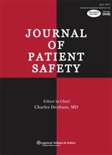
Journal of Patient Safety
Scope & Guideline
Pioneering Research for Enhanced Patient Outcomes
Introduction
Aims and Scopes
- Patient Safety Culture and Reporting Systems:
Research in this area explores the frameworks and methodologies for assessing and improving patient safety culture within healthcare organizations, including the efficacy of incident reporting systems. - Adverse Events and Risk Management:
The journal publishes studies that investigate the nature, causes, and consequences of adverse events in healthcare, focusing on risk management strategies to prevent harm to patients. - Interventions and Quality Improvement:
A core focus is on the development and evaluation of interventions aimed at enhancing patient safety, including quality improvement initiatives, clinical decision support systems, and educational programs. - Healthcare Technology and Safety:
Papers explore the role of technology in patient safety, including the use of electronic health records, telehealth, and automated systems to reduce errors and improve patient outcomes. - Patient and Family Engagement:
This scope includes research on how involving patients and families in safety practices can lead to better health outcomes and enhance the overall safety culture. - Health Policy and Patient Safety:
The journal addresses the implications of health policy decisions on patient safety, examining how regulations and guidelines affect practices within healthcare settings.
Trending and Emerging
- Integration of Technology in Patient Safety:
Recent studies highlight the increasing role of technology, such as AI and machine learning, in enhancing patient safety through improved monitoring, reporting, and decision-making processes. - Patient-Centered Safety Initiatives:
There is a growing trend towards research that emphasizes patient-centered care, focusing on how patient and family engagement can improve safety outcomes and healthcare experiences. - Interprofessional Collaboration:
Emerging themes include the importance of collaboration among healthcare professionals, with studies examining the impact of teamwork and communication on patient safety. - Mental Health and Patient Safety:
Research on the intersection of mental health and patient safety is gaining traction, addressing unique challenges and strategies for improving safety in mental health settings. - Systemic Approaches to Safety Culture:
The journal is increasingly publishing studies that explore systemic and organizational factors affecting safety culture, emphasizing the need for comprehensive strategies rather than isolated interventions.
Declining or Waning
- Traditional Risk Management Approaches:
There is a noticeable decrease in studies focusing solely on traditional risk management approaches without integration of modern techniques, such as technology and patient engagement strategies. - Single-Dimensional Studies:
Papers that focus on singular dimensions of patient safety, such as just reporting incidents without examining broader systemic issues, are becoming less frequent as the journal emphasizes more comprehensive, multidisciplinary approaches. - Emphasis on Acute Care Settings:
Research focused exclusively on acute care settings is waning, with a shift towards understanding patient safety across a broader range of healthcare environments, including outpatient and community care. - Static Models of Patient Safety:
There is a decline in the use of static models for understanding patient safety, as the journal increasingly favors dynamic, systems-based approaches that reflect real-world complexities. - Historical Analyses of Patient Safety Events:
Papers providing purely historical analyses of patient safety events without actionable insights or contemporary relevance are less common, as the focus shifts to actionable research and future implications.
Similar Journals
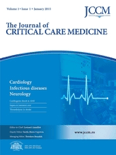
Journal of Critical Care Medicine
Elevating emergency medicine with cutting-edge insights.The Journal of Critical Care Medicine, published by SCIENTO, is a pioneering open-access journal dedicated to advancing the field of critical care, emergency medicine, anesthesiology, and pulmonary medicine. Since its inception in 2015, this journal has made significant strides in fostering knowledge dissemination and scholarly communication within the medical community. With an ISSN of 2393-1809 and an E-ISSN of 2393-1817, it provides a platform for high-quality research that impacts clinical practices and improves patient outcomes. Currently ranked in the second and third quartiles across multiple categories such as Critical Care and Intensive Care Medicine, and Emergency Medicine, the journal’s impact is underlined by its inclusion in prestigious databases like Scopus. The journal’s commitment to open-access publishing ensures that vital research is accessible to a wider audience, enriching the global dialogue in critical care practices. Researchers, healthcare professionals, and students seeking to remain at the forefront of this rapidly evolving field will find an invaluable resource in the Journal of Critical Care Medicine.
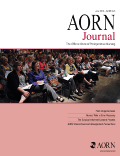
AORN JOURNAL
Fostering Growth in Medical and Surgical Nursing.AORN JOURNAL, a reputable publication in the field of Medical and Surgical Nursing, has been at the forefront of nursing education and practice since its inception in 1963. Published by WILEY, this peer-reviewed journal serves as an essential resource for nurses, educators, and healthcare professionals seeking to enhance their knowledge and skills in perioperative care. With an impressive ranking of 15th out of 26 in its category according to Scopus, and a Q2 rating in the 2023 category quartiles, the AORN JOURNAL consistently provides high-quality research, innovative practices, and evidence-based guidance. While currently not an open-access journal, it offers valuable insights and practical solutions to complex challenges in surgical settings, making it a crucial tool for advancing the nursing profession. The journal's commitment to fostering excellence in patient care continues to empower professionals and students alike, ensuring they stay at the leading edge of medical knowledge and practice.

AMERICAN JOURNAL OF MEDICAL QUALITY
Empowering Practitioners with Cutting-Edge Quality ResearchAmerican Journal of Medical Quality is a pivotal publication in the field of healthcare quality and medical policy, published by Lippincott Williams & Wilkins. Since its inception in 1992, the journal has become a critical resource for researchers, practitioners, and students dedicated to improving patient care and health systems through evidence-based practices. With a current impact factor that reflects its significance in the arena of medicine and health policy, the journal falls within the Q3 category in both Health Policy and Medicine (Miscellaneous) as of 2023, ranking 253rd out of 636 in general medicine according to Scopus metrics. This underscores its relevance and prominence among peers. The journal's scope encompasses a diverse range of topics related to quality improvement initiatives, healthcare delivery systems, and policy analysis, making it an essential read for anyone invested in advancing medical quality standards and practices. While it is not an open-access journal, the content is meticulously curated to enrich the academic discourse and inform best practices in medical quality. With an ongoing commitment to addressing contemporary challenges in healthcare, American Journal of Medical Quality serves as an influential platform for advancing the knowledge and implementation of quality initiatives in medical settings.
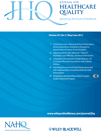
Journal for Healthcare Quality
Elevating standards through innovative research.Journal for Healthcare Quality, published by Lippincott Williams & Wilkins, serves as a vital platform for disseminating innovative research and insights in the fields of health policy, public health, and medicine. With an ISSN of 1062-2551 and an E-ISSN of 1945-1474, this esteemed journal has been contributing to the improvement of healthcare practices since its inception in 1992. Positioned in the Q3 quartile across its relevant categories as of 2023, it addresses critical issues affecting healthcare quality and policy, demonstrating its commitment to advancing the field. Although it does not currently offer open access, the journal provides researchers and practitioners with an invaluable resource for enhancing their knowledge and practice through peer-reviewed articles aimed at an audience dedicated to improving health outcomes. Located in Philadelphia, the journal continually strives to bridge the gap between research and practical application, making it a cornerstone for those looking to impact healthcare quality.

International Journal of Clinical Pharmacy
Elevating Clinical Practices with Groundbreaking FindingsThe International Journal of Clinical Pharmacy, published by Springer, serves as a pivotal platform for advancing research in the fields of Pharmaceutical Science and Pharmacology. This esteemed journal, recognized for its significant impact with an impressive Q1 ranking in Pharmacy and multiple Q2 designations, provides a dedicated space for scholars and practitioners to share innovative findings and methodologies that enhance clinical pharmacy practices. With an international reach and publication spanning from 2011 to 2024, the journal aims to facilitate knowledge exchange among researchers, professionals, and students, ultimately contributing to improved therapeutic outcomes. As an open-access journal, it promotes widespread dissemination of vital research, ensuring that cutting-edge clinical pharmacy knowledge is accessible to all stakeholders in the healthcare continuum.
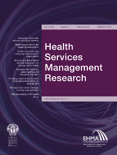
Health Services Management Research
Catalyzing Change in Health Services Through ResearchHealth Services Management Research is a premier academic journal published by SAGE PUBLICATIONS LTD, focusing on critical areas within the health policy domain. With an ISSN of 0951-4848 and E-ISSN 1758-1044, this UK-based journal has been a valuable resource for over three decades, converging from 1988 to 2024. Recognized for its contribution to the field, it holds a commendable Q2 quartile ranking, positioning it in the top 35% of journals in Health Policy, reflecting its significant impact within the academic community, as evidenced by its rank of 109 out of 310 in Scopus rankings, placing it in the 65th percentile. The journal aims to foster innovative research that addresses the complexities of health services management, making it an indispensable resource for researchers, professionals, and students dedicated to improving health systems. Although it currently does not offer Open Access, the journal remains committed to advancing knowledge and practice in health policy management through rigorous peer-reviewed articles, case studies, and evidence-based analyses.

INTERNATIONAL JOURNAL OF HEALTH CARE QUALITY ASSURANCE
Advancing Excellence in Health Care QualityINTERNATIONAL JOURNAL OF HEALTH CARE QUALITY ASSURANCE is a leading academic journal published by Emerald Group Publishing Ltd, dedicated to advancing the fields of health care quality and health policy. Established in 1988, this esteemed journal addresses critical issues in health care management, offering insights into best practices and innovative strategies to enhance quality assurance in diverse health care settings. With an impact factor that places it in the Q3 tier across both health policy and business management categories, the journal serves as a valuable resource for researchers, practitioners, and students seeking to contribute to the conversation on health care quality improvement. Although currently not an Open Access journal, it remains accessible through various academic databases, facilitating a wide reach of its scholarly contributions. The journal's mission is to foster interdisciplinary dialogue and share evidence-based research that can inform policies and practices aimed at improving health care delivery globally.

Risk Management and Healthcare Policy
Fostering collaboration for a resilient healthcare future.Risk Management and Healthcare Policy is an esteemed Open Access journal published by DOVE MEDICAL PRESS LTD, dedicated to advancing the fields of health policy and public health. Established in 2008, the journal fosters a rich dialogue among researchers, professionals, and students, focusing on innovative strategies for managing risks within healthcare systems. With a current impact factor reflected in its robust Scopus rankings—placing it in the top quartile (Q2) in both Health Policy and Public Health, Environmental and Occupational Health—the journal is a pivotal resource that shares critical insights and evidence-based practices. The journal not only covers empirical studies and analytical research but also promotes discussions on emerging challenges and opportunities within the healthcare sector. As a result, Risk Management and Healthcare Policy serves as a vital platform for disseminating high-quality research, fostering collaboration, and informing policy decisions aimed at enhancing health outcomes globally.

Journal of Healthcare Quality Research
Bridging gaps in health policy through comprehensive research.Journal of Healthcare Quality Research is an esteemed publication dedicated to advancing the field of health policy through rigorous research and comprehensive analysis. Published by ELSEVIER ESPANA SLU, this journal serves as a vital platform for researchers, professionals, and academics striving to address critical issues affecting healthcare quality across the globe. As a Q3 ranked journal in health policy for 2023, it holds a significant position within the Scopus rankings, showcasing its role in shaping healthcare discussions and policies. The E-ISSN: 2603-6479 reflects its commitment to wide accessibility, with an objective to provide insightful contributions that bridge gaps between theory and practice. With an impressive scope that spans from 2018 to 2024, the journal not only disseminates high-quality research but also fosters collaboration among policymakers and healthcare providers, driving innovations that enhance patient care and health systems worldwide.
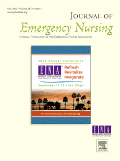
Journal of Emergency Nursing
Fostering Knowledge for Superior Patient OutcomesJournal of Emergency Nursing, published by Elsevier Science Inc, serves as a premier platform for advancing the field of emergency nursing. Since its inception in 1975, this peer-reviewed journal has established itself as a vital resource for researchers, practitioners, and educators alike, with a notable impact factor and current ranking of #8 out of 32 in the Emergency Nursing category, placing it in the 76th percentile. The journal's commitment to the dissemination of high-quality evidence, innovative practices, and essential insights makes it an indispensable tool for those seeking to excel in acute care settings. Although not open access, the Journal of Emergency Nursing is dedicated to fostering knowledge and improving patient outcomes through robust research and comprehensive reviews, aligning closely with its mission to enhance emergency nursing practices and education through every issue until 2024 and beyond. For professionals and students keen on staying at the forefront of emergency care advancements, this journal provides a wealth of knowledge and resources, reflecting the critical issues and developments shaping the future of healthcare.